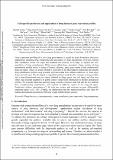Cell-specific prediction and application of drug-induced gene expression profiles
Author(s)
Hodos, Rachel; Zhang, Ping; Lee, Hao-Chih; Duan, Qiaonan; Wang, Zichen; Clark, Neil R.; Ma’ayan, Avi; Wang, Fei; Kidd, Brian; Hu, Jianying; Sontag, David Alexander; Dudley, Joel; ... Show more Show less
DownloadPublished version (1.643Mb)
Terms of use
Metadata
Show full item recordAbstract
Gene expression profiling of in vitro drug perturbations is useful for many biomedical discovery applications including drug repurposing and elucidation of drug mechanisms. However, limited data availability across cell types has hindered our capacity to leverage or explore the cell-specificity of these perturbations. While recent efforts have generated a large number of drug perturbation profiles across a variety of human cell types, many gaps remain in this combinatorial drug-cell space. Hence, we asked whether it is possible to fill these gaps by predicting cell-specific drug perturbation profiles using available expression data from related conditions--i.e. from other drugs and cell types. We developed a computational framework that first arranges existing profiles into a three-dimensional array (or tensor) indexed by drugs, genes, and cell types, and then uses either local (nearest-neighbors) or global (tensor completion) information to predict unmeasured profiles. We evaluate prediction accuracy using a variety of metrics, and find that the two methods have complementary performance, each superior in different regions in the drug-cell space. Predictions achieve correlations of 0.68 with true values, and maintain accurate differentially expressed genes (AUC 0.81). Finally, we demonstrate that the predicted profiles add value for making downstream associations with drug targets and therapeutic classes.
Date issued
2018-01Department
Massachusetts Institute of Technology. Institute for Medical Engineering & ScienceJournal
Pacific Symposium on Biocomputing
Publisher
World Scientific
Citation
Hodos, Rachel et al. "Cell-specific prediction and application of drug-induced gene expression profiles." Pacific Symposium on Biocomputing, January 2018, Kohala Coast, Hawaii, World Scientific, January 2018 © 2017 The Authors
Version: Final published version
ISBN
9789813235526
9789813235533